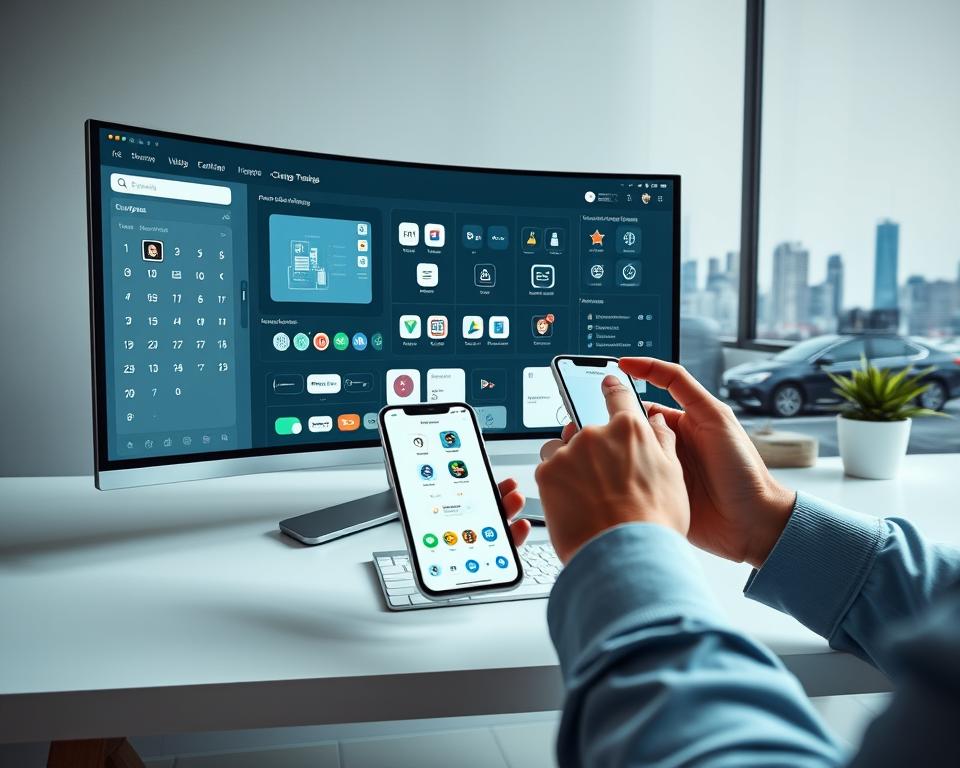No-code and low-code platforms have changed how we make apps. Now, people and businesses can create apps without needing to know how to code. This makes app development easier and faster for everyone.
The growth of no-code and low-code platforms is huge. You can learn more about them on low-code and no-code platforms. They show the benefits and possibilities of these new ways to make apps.
Now, anyone can make an app, even if they’re not tech-savvy. No-code and low-code platforms have cut down on time and money needed for app making. With the right tools, anyone can make a custom app, no matter their coding skills.
In this guide, we’ll dive into no-code and low-code app development. We’ll show you how to make a no-code or low-code app step by step.
Table of Contents
Key Takeaways
- No-code development and low-code platforms have made app development more accessible and efficient.
- These approaches have opened up new opportunities for individuals and businesses to create custom apps.
- No-code development and low-code platforms have reduced the time and cost associated with traditional app development.
- Non-technical individuals can build apps using no-code development and low-code platforms.
- The right tools and platforms are necessary to create a custom app using no-code or low-code development.
- This guide will provide a step-by-step guide on how to build a no-code or low-code app.
Understanding No-Code and Low-Code Development
No-code and low-code development are key parts of digital transformation. They let businesses make apps without needing to know how to code. No-code tools use a visual interface for building apps, letting users drag and drop components. Low-code solutions offer a coding experience but with some automated features.
These platforms change how companies make software. They make it faster and easier to use. With no-code tools, you can make custom apps without coding. Low-code solutions need some coding but still save a lot of time.
No-code and low-code platforms differ in coding needs, project complexity, and audience. No-code tools are great for simple apps, like prototypes or small projects. Low-code solutions are better for complex apps that need customization and integration with other systems.
Examples of no-code tools include website builders and graphic design software. Low-code solutions include app development platforms and database management systems. Using these platforms helps businesses speed up digital transformation, boost efficiency, and cut costs of traditional software development.
Benefits of Building Apps Without Traditional Coding
Building apps without coding has many benefits. It includes rapid development and cost-effective solutions. No-code and low-code platforms let businesses make custom apps fast and without needing a big team of developers.
The advantages of no-code and low-code platforms are:
- Faster time-to-market for apps
- Lower development costs
- Increased flexibility and scalability
- Easier maintenance and updates
These perks make no-code and low-code platforms great for businesses. They can create custom app creation solutions without spending a lot. This way, companies can focus on their main activities while still making high-quality apps for their customers.
In summary, the benefits of coding-free app building are obvious. With rapid development and cost-effective solutions, businesses can stay competitive. They can also deliver innovative apps to their customers.
| Platform | Benefits |
|---|---|
| No-code | Faster development, lower costs |
| Low-code | Increased flexibility, easier maintenance |
Essential Tools and Platforms for App Development
Developers have many tools and platforms to build apps. No-code and low-code tools are popular for quick app creation. App building software offers various options for different needs.
Popular No-Code Platforms
No-code platforms change how apps are made. They let developers build apps without needing to code. Some top no-code platforms are:
- Adalo
- Appy Pie
- GoodBarber
Leading Low-Code Solutions
Low-code tools offer a coding approach but with more features. They include:
- Mendix
- OutSystems
- Microsoft Power Apps
Choosing the Right Platform for Your Project
When picking a platform, think about scalability and device support. For more on affordable app development, visit nextbigtechnology. The right platform ensures a smooth app development process.
Choosing the right platform is key to a successful app. Whether it’s no-code, low-code, or app building software, the right tool makes all the difference.
Planning Your App Development Journey
When planning your app, having a clear strategy is key. You need to set project goals, know your target audience, and sketch out the app’s layout. This planning ensures your project stays on track and meets your goals.
Effective project management means breaking tasks into smaller steps and setting achievable deadlines. Using a no-code strategy can make this easier. It simplifies the process and cuts down on the need for complex coding.
Using a no-code approach offers several advantages:
- It saves time in development.
- It can lower costs.
- It boosts flexibility.
These benefits help you create a top-notch app that meets your needs and goes beyond your expectations.
Good app development planning and project management are vital for a successful app. With a solid plan and the right tools, you can turn your app idea into reality and reach your goals.
How to Build a No-Code or Low-Code App: Step-by-Step Process
Creating a no-code or low-code app needs a clear plan. The first step is to define what the app will do. This means knowing who it’s for, its purpose, and what features it will have. By following these steps, developers can make an app that is both strong and easy to use.
Next, you need to design the app’s structure. This includes the layout, how users will move around, and how it will feel to use. A good design is key because it affects how users feel about the app. To learn more about making an app, check out this app development guide.
Defining Your App Requirements
This step is about researching the market and understanding what makes your app special. Knowing what your app needs helps you make something that really meets your audience’s needs.
Creating Your App Architecture
A good app structure is vital for a great user experience. It’s about designing how the app looks and works. By planning carefully, you can make an app that works well and looks good too.
Building the User Interface
The last step is to make the app’s interface. This is where you use no-code or low-code tools to make the app real. These tools help you create an app that’s easy to use without needing to know how to code.
When building the interface, remember a few things:
- Make navigation easy for users
- Design a layout that looks good
- Make sure it works well on all devices
Designing User-Friendly Interfaces
User interface design is key to a successful app. A good interface makes the app easy to use. Developers use UX principles to make navigation simple, information clear, and design attractive.
No-code UI tools help developers create great interfaces without needing to code. These tools offer many features to design and layout apps. Adalo, Bubble, and Webflow are some popular ones.
Key things for a user-friendly interface include:
- Simple and consistent navigation
- Clear and concise labeling
- Visually appealing design and layout
- Intuitive feedback and interaction
By using these principles and no-code tools, developers can make interfaces that users love. This makes their app stand out.
| No-Code UI Tool | Features | Pricing |
|---|---|---|
| Adalo | Drag-and-drop interface, custom design, real-time collaboration | Free plan available, paid plans start at $50/month |
| Bubble | Visual programming, responsive design, integrations with third-party services | Free plan available, paid plans start at $25/month |
| Webflow | Design and development tools, CMS, e-commerce integration | Free plan available, paid plans start at $12/month |
Data Management and Integration
Effective data management is key for app success, especially in no-code and low-code development. When making an app, think about how you’ll manage and integrate data. This ensures smooth function and data security. You need to set up databases, link with external APIs, and keep user data safe.
To do this, follow best practices for API integration. Use secure data transfer protocols and access controls to block unauthorized data access. Also, encrypt user data to protect it during and after transfer.
- Setting up databases to store and manage app data
- Implementing API integration methods to connect with external services
- Ensuring data security through encryption, access controls, and secure protocols
By sticking to these best practices, you can manage data well. This makes your app secure and easy to use for everyone.
Testing and Quality Assurance
Quality assurance is key in app development to meet standards. App testing is vital, and no-code tools make it easier. These tools let developers test apps without needing to code.
Testing focuses on how well the app works, how easy it is to use, and its speed. No-code tools help with these tests, making them quick and simple. This means developers don’t need a lot of technical know-how.
Having a solid testing plan is crucial for app quality. This plan should mix manual and automated tests, and test continuously. With no-code tools and a good plan, apps can meet high standards and offer a great user experience.
Using no-code testing tools has many benefits. These include:
- Increased efficiency
- Improved accuracy
- Reduced costs
Investing in quality assurance and testing ensures apps are reliable and efficient. This leads to a better user experience and higher customer satisfaction.
Deployment and Launch Strategies
Getting an app ready for launch is key to success. It involves preparing the app, making a marketing plan, and tracking user engagement. Good launch strategies can boost the app’s visibility and appeal.
Deploying the app to app stores is a big step. It needs careful planning to ensure a smooth launch. By optimizing the app’s visibility, developers can attract more users.
Preparing for App Launch
To get ready for launch, developers should do final checks, make a marketing plan, and set up analytics. This means testing for bugs, improving performance, and making sure it meets user needs.
Distribution Channels
There are many ways to deploy an app, like app stores, web platforms, and enterprise distribution. Each has its own rules and benefits. Developers should pick the best ones for their app and audience. Using different channels can help reach more people and increase downloads.
Some popular ways to distribute apps include:
- App stores, such as Apple App Store and Google Play
- Web platforms, like progressive web apps and responsive web apps
- Enterprise distribution, like internal app stores and mobile device management solutions
By choosing the right channels and launch strategies, developers can make their app deployment successful. This increases their chances of success in the app market.
Maintenance and Updates
After launching a no-code or low-code app, it’s key to do regular app maintenance. This keeps the app stable and secure. It includes watching user feedback, fixing bugs, and adding updates to boost performance and features.
Listening to user feedback is vital to enhance the app’s user experience. You can gather feedback through surveys, reviews, or social media. Then, use this feedback to make informed decisions about updates. Also, using version control systems helps track app changes. This ensures all updates are documented and tested.
Some important tasks in app maintenance are:
- Regularly backing up data to prevent loss
- Monitoring app performance and fixing bugs
- Implementing security updates to prevent vulnerabilities
By focusing on app maintenance and updates, developers can keep their app competitive, secure, and user-friendly. Version control systems also make development easier. They help teams work together and track changes.
Common Challenges and Solutions
When you make apps with no-code or low-code tools, you might face some hurdles. These can include issues with scaling and customizing your app. You might also hit limits with integrating and making your app run smoothly.
Some common problems you might run into are data integration issues, limits in designing the user interface (UI), and troubleshooting problems. To tackle these, knowing what your platform can and can’t do is key. Also, being good at troubleshooting is crucial.
- Identify the root cause of the issue through thorough troubleshooting
- Utilize platform-specific resources and support services
- Leverage online communities and forums to connect with other developers and learn from their experiences
Knowing about these challenges and having a plan to deal with them can help your app succeed. Good troubleshooting and problem-solving skills are vital. They help you overcome no-code and low-code hurdles and ensure your app’s long-term success.
Cost Considerations and ROI
Understanding the costs of no-code and low-code app development is key. No-code often means lower initial costs because it uses pre-made templates and drag-and-drop tools. Low-code pricing can change based on the platform and how much customization you need.
It’s important to calculate the return on investment (ROI) for any app project. This includes looking at platform fees, personnel costs, and marketing expenses. Using a low-code platform can help save time and money. This can lead to a better ROI. For example, a study by Next Big Technology shows low-cost app development can be a smart choice for businesses. Some platforms even offer free trials or flexible pricing plans.
Here are some key factors to consider when evaluating no-code costs and low-code pricing:
- Initial investment requirements
- Ongoing maintenance costs
- ROI calculation
By carefully looking at these factors and the benefits of no-code and low-code, businesses can make smart choices. This can help them get a better return on investment for their app projects.
Scaling Your App for Growth
As your no-code or low-code app becomes more popular, it’s crucial to plan for app scaling. This ensures a smooth experience for users. You need to implement growth strategies that can handle more traffic and add new features without slowing down. A big part of no-code scalability is watching analytics to find areas to improve.
Some important things to think about when scaling your app include:
- Using cloud services to manage more traffic and data
- Adopting agile development to quickly scale and update
- Using load balancing and caching to boost performance
By focusing on app scaling and using good growth strategies, your app will stay fast, secure, and user-friendly. This is where no-code scalability helps, letting you grow your app fast and easy without needing to know how to code.
By following these tips and focusing on app scaling and growth strategies, you can make sure your no-code or low-code app does well. It will keep growing and thriving.
Conclusion
No-code app development and low-code platforms have changed how we make custom apps. Now, people and businesses can turn their ideas into reality without needing to know how to code. With the right tools, anyone can make an app that fits their needs.
Whether you want a simple app or something more complex, these platforms offer the flexibility and growth you need. They help you reach your goals.
When starting your app-making journey, pick a platform that fits your needs and goals. Look at how easy it is to use, how much you can customize, and how well it integrates with other systems. No-code and low-code platforms help you make an app that boosts your business, improves customer interaction, or brings your unique idea to life.
If you want to learn more about no-code app development and low-code platforms, there are many resources out there. You can find tutorials, webinars, and online courses. By using these resources and keeping up with new trends and best practices, you can fully use no-code and low-code platforms. This way, you can create custom apps that lead to success.



















